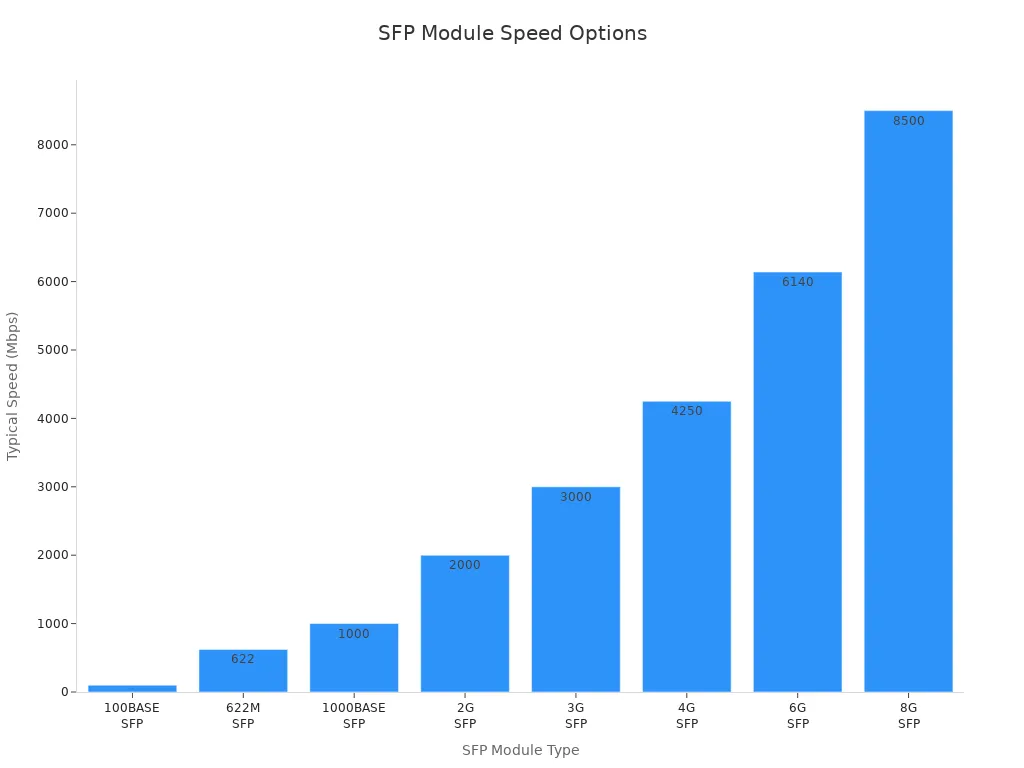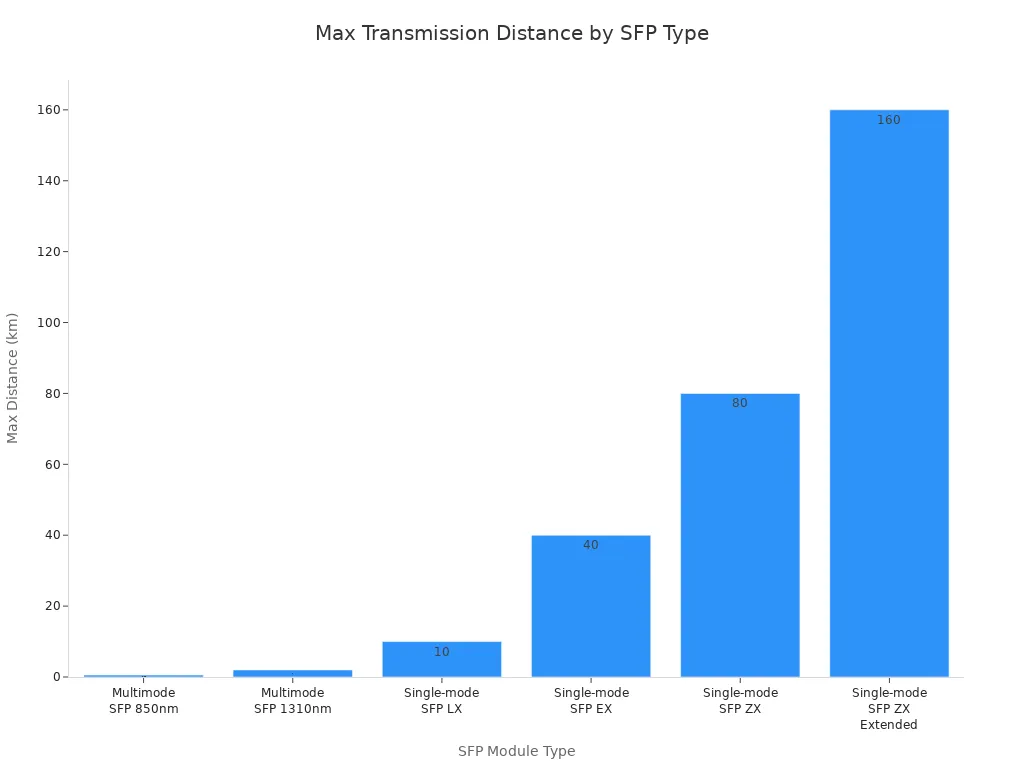
A small form-factor pluggable, or SFP optic module, helps connect network devices fast. You can use an SFP optic module to turn electrical signals into optical signals. It also changes optical signals back into electrical signals. This lets you send data far away. SFP modules work in many network places, like data centers and big company networks. You can take them out and put new ones in without turning off your system. This keeps your network easy to change and upgrade.
-
SFP modules work with different speeds and types, like fiber and copper.
-
You see SFP modules used a lot in Ethernet links, storage networks, and fast data center jobs.
Key Takeaways
-
SFP optic modules change electrical signals into optical signals. They also change optical signals back to electrical signals. This helps data move fast and far. These modules are small and easy to plug in or take out. You can upgrade them without turning off your network. SFP modules work with different speeds and cable types. They also work for many distances. This makes them good for many networks, like offices and data centers. Always make sure your SFP module matches your network device. This helps you avoid connection problems. It also keeps your network working well. Keep connectors clean and handle modules with care. This helps your network stay strong and reliable. It also stops common problems.
SFP Optic Module Basics

What Is SFP
You will see SFP a lot when working with network gear. SFP means small form-factor pluggable. This device is a small transceiver you plug into a switch, router, or server. The main job of an SFP optic module is to change electrical signals into optical signals for fiber cables. It can also turn optical signals back into electrical signals for copper cables. This lets you send data fast and far.
Groups that set network rules use the Multi-Source Agreement (MSA) to say what an SFP optic module should do. These rules cover the size, shape, and how each SFP connects. They also explain how the module talks to your network device. Because of these rules, you can use SFP modules from different brands in the same device. You do not have to worry about them working together if they follow the same MSA rules.
Tip: Always make sure your SFP optic module fits the port and speed your network device needs. This helps stop connection issues.
You can get SFP modules that work at many speeds, from 100 Mbps up to 100 Gbps. They work with different cables, like copper or fiber. They also fit different connectors, such as LC or RJ-45. This makes the SFP optic module very useful in today’s networks.
Small Form-Factor Pluggable Features
The small form-factor pluggable design gives you many good things:
-
Hot-Pluggable: You can add or remove an SFP module without turning off your device. This keeps your network working while you change or upgrade modules. You save time and do not have to stop your network.
-
Compact Size: SFP modules are smaller than old transceivers. Their small size lets you put more ports on your network gear. This helps you build networks with lots of connections in small spaces.
-
Versatility: You can use SFP modules with many cable types. Pick from twisted pair copper, twinaxial copper, multi-mode fiber, or single-mode fiber. This lets you build your network the way you want.
-
Wide Range of Speeds and Distances: SFP modules support many data rates, usually up to 1.25 Gb/s for regular SFP and higher for SFP+ models. You can connect devices over short distances (about 100 meters with copper) or very long distances (up to 80 kilometers with single-mode fiber).
-
Secure Connection: When you plug in an SFP module, you hear a click. This sound means the module is locked in and ready.
-
Diagnostic Features: Many SFP modules have LED lights and built-in checks. These help you see link status and fix problems fast.
Because SFP modules are hot-swappable, you can keep your network running. You do not need to turn off your equipment for upgrades or repairs. This makes it easier to keep your network working well.
You can count on the SFP optic module for flexibility, speed, and reliability. Its small form-factor pluggable design helps you build networks that are easy to manage and upgrade.
How SFP Works
Signal Conversion
When you use an SFP module, it helps your network send data far. The SFP transceiver has two main parts inside. One part is the transmitter. The transmitter takes electrical signals from your device. It changes them into light pulses. It uses a laser diode or an LED for this job. The light pulses move through the fiber optic cable as binary data.
The other part is the receiver. The receiver gets the light pulses at the end. It uses a photodiode to turn the light back into electrical signals. A microcontroller checks the timing and format of these signals. Then it sends them to your device. This lets your network devices talk to each other fast and clearly, even if they are far apart.
You can see how the main parts work together in the table below:
|
Component Name |
Function in Signal Conversion |
|---|---|
|
Changes electrical signals into optical signals using a laser diode. |
|
|
Receiver Optical Sub Assembly (ROSA) |
Converts optical signals back into electrical signals with a photodiode. |
|
Controls the laser diode for accurate light pulses. |
|
|
Clock and Data Recovery (CDR) |
Keeps the timing of the data correct. |
|
Trans-Impedance Amplifier (TIA) |
Boosts the signal from the photodiode. |
|
Limiting Amplifier (LA) |
Makes sure the signal stays strong and clear. |
|
Micro-Controller Unit (MCU) |
Manages the module and checks performance. |
Industry standards help SFP modules work with many brands. The Multi-Source Agreement (MSA) sets rules for how SFP transceivers should look and work. IEEE 802.3 covers Ethernet networking. SFF-8472 adds digital monitoring features. These rules make it easy to use SFP modules from different companies.
Note: An SFP optical transceiver follows these rules so you can trust it to work in many networks.
Hot-Swappability
Hot-swappability is a great feature of an SFP transceiver. You can plug in or take out an SFP module while your device is still on. You do not have to turn off your switch or router to upgrade, replace, or fix a module.
With hot-swappable SFP modules, your network keeps running. You save time and avoid long breaks. This is very important in places like data centers.
-
You can change a broken transceiver without stopping everything.
-
You can upgrade to a faster SFP module as your network grows.
-
You can try different SFP modules to see which one works best.
Tip: Always make sure the new SFP module matches your device’s speed and port type before you swap.
Hot-swappability gives you more control and flexibility. You can keep your network working, even during upgrades or repairs.
SFP Module Types

Media Types
There are different media types for an sfp module. Each one is good for certain network jobs. The main types are multi-mode fiber, single-mode fiber, and copper cables. The table below explains how each type works and why it is helpful:
|
Media Type |
Description |
Advantages |
|---|---|---|
|
Multi-mode Fiber |
Uses LED light, supports short distances (up to 550m at 850nm, up to 2km at 1310nm) |
Cost-effective for short-range applications |
|
Single-mode Fiber |
Uses laser light, supports long distances (2km to 120km, wavelengths 1310nm to 1550nm) |
Higher data rates, longer transmission distances |
|
Copper (Ethernet) |
Uses CAT5 UTP cable, supports up to 100 meters, RJ45 interface |
Cost-effective for short distances, easy to use with Ethernet |
Copper sfp modules are good for short links in offices. Multi-mode fiber is best for connecting devices in the same building. Single-mode fiber lets you send data very far, even to other cities.
Tip: SFP modules work with both fiber optic and copper cables. This helps you make networks that fit your needs.
Speed Options
Sfp modules come in many speeds. Some transceivers support 100 Mbps, while others go up to 10 Gbps or more. The most common sfp module supports 1 Gbps. This is great for gigabit ethernet and many data jobs. If you need faster speeds, SFP+ modules can go up to 10 Gbps.
|
Speed Option |
Typical Speed |
Common Use Case / Performance Notes |
|---|---|---|
|
100BASE SFP |
100 Mbps |
Used in fast Ethernet, legacy systems |
|
1000BASE SFP |
1 Gbps |
Most popular; used in data communication |
|
SFP+ |
10 Gbps |
High-speed for data centers and telecom |

You can use sfp transceivers with RJ45 connectors for copper cables up to 100 meters. Fiber sfp modules can go much farther and have lower latency. This is important for big networks.
Distance and Applications
How far an sfp module can send data depends on its type. Multi-mode fiber modules can reach up to 550 meters at 850nm or 2 km at 1310nm. Single-mode fiber modules can go from 10 km up to 160 km, based on the model.
|
SFP Module Type |
Wavelength (nm) |
Maximum Transmission Distance |
|---|---|---|
|
Multimode SFP |
850 |
Up to 550 meters |
|
Multimode SFP |
1310 |
Up to 2 km |
|
Single-mode SFP (LX) |
1310 |
Up to 10 km |
|
Single-mode SFP (EX) |
1310 |
Up to 40 km |
|
Single-mode SFP (ZX) |
1550 |
Up to 80 km |
|
Single-mode SFP (ZX Extended) |
1550 |
Up to 160 km |
|
BiDi SFP |
Various pairs |
10 km to 160 km |
|
BiDi SFP (DWDM/CWDM) |
Multiplexed |
Up to 200 km |

You can use sfp modules in many ways:
-
In small offices, copper sfp modules connect computers and switches over short distances.
-
In big networks, multi-mode fiber sfp modules link equipment in the same building.
-
For long links, single-mode fiber sfp modules connect data centers in different cities.
-
Telecom companies use BiDi and CWDM sfp modules for metro networks and long-distance jobs.
Note: Sfp modules help you build networks for small offices, big data centers, and telecom systems.
Choosing SFP Modules
Compatibility
You should always check if the sfp module works with your device. Each switch or router may need a certain kind. Some brands, like Cisco or Aruba, want you to use their own certified modules. If you use a module that is not certified, you might lose some features or see errors. Make sure the sfp module matches the port, fiber, and speed your device uses. For example, a Cisco Catalyst switch needs a Cisco-certified 10G sfp+ module to work its best. Always check the vendor’s list before you buy.
Tip: Using the right sfp module for your device helps stop problems and keeps your network working well.
Cabling and Distance
Pick the right cable for your sfp module. The cable you choose changes how far your data can go and how much you pay. Here is a simple guide:
|
Cable Type |
Typical Distance |
Best Use Case |
Cost Impact |
|---|---|---|---|
|
Multimode Fiber |
Up to 550 meters |
Short links, data centers |
Lower |
|
Single-mode Fiber |
Up to 160 km |
Long-distance connections |
Higher |
|
Copper (UTP/DAC) |
Up to 10 meters |
Short, rack-to-rack links |
Lowest |
Multimode fiber is good for short distances in buildings. Single-mode fiber is best for long links, like between cities. Copper cables work well for short runs, like inside a server rack. Always match the sfp module to the cable and connector, such as LC or RJ45. Keep connectors clean and do not bend cables too much. This helps your network stay fast and strong.
Environment
Think about where you will use the sfp module. If you use it in an office or data center, a regular module is fine. For outdoor or tough places, you need an industrial-grade sfp. These modules can handle very hot or cold weather, from -40°C to 85°C, and high humidity. They also meet safety rules like CE, RoHS, and FCC. Using the right sfp module for your space stops problems and keeps your network safe.
Note: Always check the temperature range and safety labels before you use an sfp module in hard places.
SFP Compatibility
Common Issues
You can have problems with sfp compatibility when setting up your network. Many switches and routers only work with modules from the same brand. This is called brand lock-in. It can make a module not work, even if it meets industry rules. Some devices use special software that blocks other brands’ modules. Always check your device’s list before you buy a module.
Here are some common problems you might see:
-
You use the wrong transceiver, like SFP+ in an SFP port, and it does not work.
-
The transceiver and port do not match in speed or type.
-
The fiber cables at each end use different wavelengths, so the link fails.
-
You mix single-mode and multi-mode fibers, which causes errors.
-
Dirt or damage on connectors makes the signal weak or stops the link.
-
Vendors do not always give clear sfp compatibility info, so planning is hard.
Tip: Always use the same wavelength and fiber type on both ends. Be gentle with modules and cables to stop damage.
Troubleshooting
If you have sfp compatibility problems, you can try these steps to fix them:
-
Make sure you use the right transceiver for your port. SFP and SFP+ do not always work in the same slot.
-
Look at the transceiver, cables, and connectors for dirt or damage. Clean them if you need to.
-
Take out the transceiver and put it back in to check if it fits right.
-
Try the module in another port or device. This helps you see if the problem is with the port or the module.
-
Use tools to check signal strength and power levels. Make sure both ends use the same wavelength.
-
Update your device’s software. New updates can help with sfp compatibility.
-
If nothing works, try a working module or ask your vendor for help.
|
Step |
What to Do |
Why It Helps |
|---|---|---|
|
Check compatibility |
Make sure the transceiver and port match |
Stops speed and link problems |
|
Inspect hardware |
Look for dirt, dust, or damage |
Fixes connection issues |
|
Test with working parts |
Finds broken parts |
|
|
Use diagnostics |
Check power and wavelengths |
Finds signal and wavelength issues |
|
Install new updates |
Helps with recognition and stability |
Note: Keeping your network clean and using the right parts helps you avoid most sfp compatibility problems.
You have learned that an sfp module helps your network go faster. It also makes your network easy to change and upgrade. To keep things working well, always do these things:
-
Make sure the sfp module works with your device and fits your network’s speed and distance.
-
Wipe connectors clean and put extra transceivers in a safe place.
-
Watch how your network is doing and update firmware to stop problems.
If something goes wrong, try these steps:
-
Take out the module and put it back in, then check the lights.
-
Only swap out broken parts if you really need to.
Good choices and regular care help your network stay strong and work well.
FAQ
What does "hot-swappable" mean for SFP modules?
You can remove or insert an SFP module while your device stays powered on. This feature lets you upgrade or replace modules without shutting down your network.
Can you use any SFP module with any switch?
Not always. Some switches only work with certain brands or models. You should check your device’s compatibility list before you buy or install an SFP module.
How do you know if an SFP module is working?
Most devices have LED lights near the SFP port. A green or blinking light usually means the module works. You can also check your device’s software for link status.
What is the difference between SFP and SFP+?
SFP modules support speeds up to 1 Gbps. SFP+ modules support higher speeds, usually up to 10 Gbps. You should choose the right type for your network speed needs.
Do SFP modules need special care?
Yes. Keep the connectors clean and avoid touching the ends. Store unused modules in a dust-free case. Handle modules gently to prevent damage.

